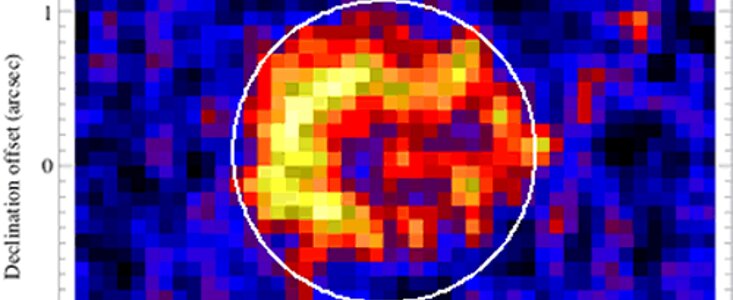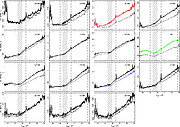Mid-Infrared Astronomy in Full Swing at Gemini
10 March 2006
Gemini Observatory has worked since its inception to become a unique facility offering northern and southern sky coverage with telescopes fully optimized for mid-infrared (7-25 micron) observing. MICHELLE, the Gemini North mid-infrared imager and spectrometer, was first on the scene, initially operating only in a purely imaging mode for the scientific community in semester 2003B. During that same time, commissioning also began for T-ReCS
(the Thermal-Region Camera and Spectrograph) at Gemini South. Since 2003B, Gemini staff members have made tremendous progress in enhancing and improving the mid-infrared performance of our telescopes and instruments. Now, more than ever, Gemini is poised to make great strides in understanding our mid-infrared universe.
Gemini Mid-Infrared Capabilities are Better than Ever
Among the improvements and enhancements, the 2006A semester marks the commissioning of the imaging polarimetry mode of MICHELLE. Our mid-infrared instruments are now fully operational for the upcoming 2006B semester and performing better than ever. Concerted efforts since 2003 have focused on improving mid-infrared image quality, increasing delivered sensitivity, and reducing instrument noise. Our instruments are now more reliable and productive, with shortened acquisition times and increased observing efficiencies. (See the articles: "Observing Efficiency at Gemini Observatory" and "Gemini Queue Operations and Completion Rates" in the December 2005 issue of GeminiFocus).
Within the last year Gemini has finally achieved true queue observing, with any instrument available at any time during the night. This is especially important for mid-infrared observations, which require more stringent observing conditions that can be highly variable. This means more efficient use of low water vapor and cloudless conditions throughout the entire semester, which translates to higher completion rates for mid-infrared observing programs. This, combined with the arrival of a water vapor monitor at Gemini South and improved weather forecasting and real-time weather feedback, means that PIs will be getting more data with even better matching to the observing conditions requested.
Furthermore, the staff at Gemini has developed a technique that provides the unique ability to acquire sources with extremely accurate mid-infrared absolute astrometry (<~0.3"). This is extremely valuable for those who wish to observe sources not visible in the optical and compare the spatial relationships between morphologies in the mid-infrared to other wavelengths. And finally, both Gemini North and South telescope primary and secondary mirrors are now silver-coated, bringing the observatory's total emissivity in the mid-infrared regime down to values lower than any other 8-meter telescope in the world. This translates to more sensitive system performance for both MICHELLE and T-ReCS.
Ground-Based Mid-Infrared Observing in the Spitzer Era
While MICHELLE and T-ReCS are extremely sensitive ground-based mid-infrared instruments, no ground-based mid-IR instrument can match the sensitivity of the Spitzer Space Telescope (Spitzer). However, where both Gemini instruments excel is in their ability to deliver high-spatial resolution imaging and spectral observations. Gemini’s mid-infrared facility instruments can routinely achieve 6 times better spatial resolution at 8 microns than Spitzer (see Figure 1).
With slit widths that are up to 18 times narrower than on Spitzer, spectroscopy with MICHELLE and T-ReCS can be performed on individual sources with no contamination, even in highly crowded areas. Extended sources can be mapped spectrally with higher spatial detail (see Figure 2). Furthermore, while Spitzer has similar spectral resolution to the T-ReCS and MICHELLE low-resolution modes (R~100), the Gemini instruments can achieve much higher spatial resolutions in the 8- to 13-micron spectral window than Spitzer. especially using the R~30,000 echelle mode of MICHELLE.
With such different capabilities, the mid-infrared instruments of Gemini Observatory complement well those of Spitzer. MICHELLE and T-ReCS present excellent opportunities not only for exciting projects in their own right, but also for high spatial and spectral resolution follow-up observations of Spitzer projects.
New Mid-Infrared Opportunities for a New Semester
As mentioned earlier, the imaging polarimetry mode on MICHELLE is new to the 2006B semester. Mid-infrared polarimetry on an 8-meter telescope is something unique to Gemini and represents our commitment to exploring new facets of mid-infrared observing.
An exciting new opportunity this next semester is also available with the coming of the University of Texas TEXES (Texas Echelon Cross Echelle Spectrograph) instrument. This high-resolution mid-infrared spectrograph is able to achieve an amazing resolution of R~100,000 in the mid-infrared from 5-25 microns. Its unique capability will only be available at Gemini North and PIs from the community are required to collaborate with members of the TEXES team. Gemini believes that the capabilities of both TEXES and the MICHELLE imaging polarimetry mode will lead to ground-breaking work in two relatively new areas of mid-infrared science with large discovery space.
Are You New to the Mid-Infrared?
Maybe you have an idea for a great mid-infrared project but have not previously observed in the mid-infrared. Perhaps you have tried unsuccessfully to obtain T-ReCS or MICHELLE time. In an attempt to bring more scientists to the mid-infrared PI pool, Gemini is encouraging astronomers, especially those new to the mid-infrared, to contact Gemini mid-infrared staff members (below). The expert knowledge of Gemini staff can be beneficial from the initial proposal stage to the conclusion of your project. They can be invaluable sources of advice in the technical aspects of your proposals as well as the data reduction and interpretation of results.
Gemini mid-infrared staff are ready to help any proposers or PIs wishing to submit proposals for mid-infrared programs (remember the deadline for 2006B is March 31th).
Links
Contacts
Rachel Mason
Email:rmason@gemini.edu
James Radomski
Email:jradomski@gemini.edu
James De Buizer
Email:jdebuizer@gemini.edu
Scott Fisher
Email:sfisher@gemini.edu
Kevin Volk
Email:kvolk@gemini.edu
Inseok Song
Email:isong@gemini.edu
Tom Geballe
Email:tgeballe@gemini.edu
Tom Hayward
Email:thayward@gemini.edu





